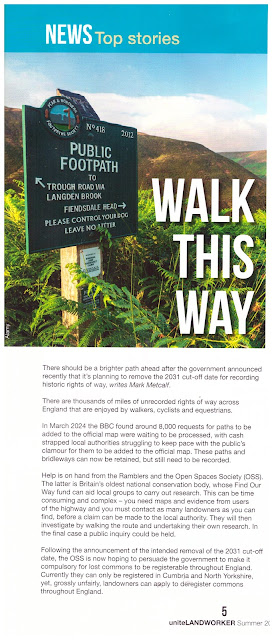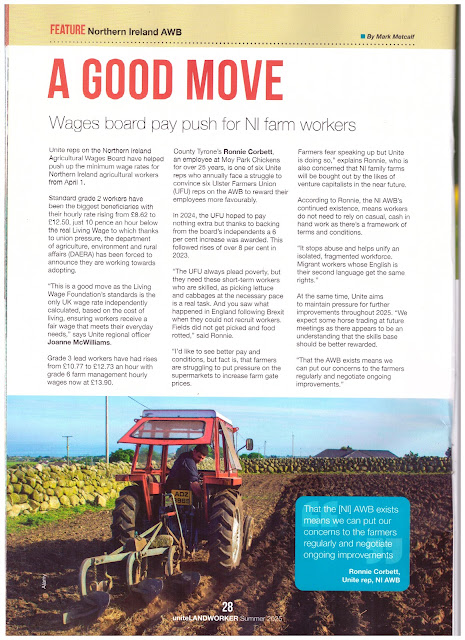This is my article on this years Durham Miners' Gala - the full version that includes Mark Harvey's great photos is online at link below
'Unity is strength'
News
Feature
Unite celebrates Durham Miners' Gala 'Big Meeting' 2025
https://unitelive.org/unite-durham-miners-gala-big-meeting-2025/
Many Unite members were part of a mighty crowd of well over
150,000 on Saturday (July 13) as the Durham Miners’ Gala ‘Big Meeting’ retained
its place as the largest annual labour movement gathering in the country.
Platform speakers included for the second time Unite general
secretary Sharon Graham, whose descendants include her great uncle who was
killed in the Durham coalfield in 1921. He left behind a wife and two young
children who received meagre compensation.
On a much happier note, there was also a special moment for
two Unite members on the march, with Indea accepting Ed Ive’s marriage proposal
to the approval of those gathered (pictured below). Congratulations to them.
The large attendance is a testimony to the resilience of the
miners who were faced with an attendance of little more than 10,000 in 1986.
With most mines earmarked for closure by the Thatcher government following the
year-long 1984-85 strike, it would have been easier to announce the ending of
an event that first began in 1871. Why not slip quietly into the night?
There was never really any likelihood of that when such as
Dave Hopper and David Guy, now long since gone, were alive. Comrades, we salute
you. There are now no pits, but as Durham Miners Association (DMA) general
secretary Alan Mardghum told the crowds, this special day continues to bloom
because it “promotes a message of hope, of sticking together, that unity is
strength.”
It was the 139th Gala and following last
year’s soaking, as Unite member Mick Joyce (pictured below) from Pelton told
the world, “The traditional sunny day has returned.”
Ice cream sellers cashed in as families and friends made
their way through the historic city of Durham with its magnificent castle and
cathedral.
Banners were raised and the brass bands, including Unite’s
very own, had the crowds singing and cheering along.
Refreshments were needed as such is the crowds it takes
three hours — long enough to strike up new friendships — to move just a mile
through the narrow, cobbled streets to the Racecourse Ground next to the River
Wear.
Afterwards, there is time to allow for a well-deserved rest
at the Unite refreshment tent before there’s a chance to listen to the
speakers. In addition to Alan Mardghum and Sharon Graham speakers
included RMT general secretary Eddie Dempsey, Chris Peace of the Orgreave Truth
and Justice Campaign, Matt Wrack from the NASUWT teachers union and last, but
by no means least, Husam Zamlot, Ambassador to the UK for the State of
Palestine.
The large Unite contingent, suitably dressed in red t-shirts
with the slogan Reclaiming our working class on the back
included delegations with their banners from the North East Yorkshire and
Humber region, Leeds City Council, Nissan, the London and Eastern Region, West
Midlands Region, East Midlands Young Members, F&R nationally that protects
firefighters, North West Service Industries and the Central London Voluntary
Sector.
They were buoyed throughout by the brass band which is based
in Sheffield, home for many years to the headquarters of the National Union of
Mineworkers, at one time the most powerful union in the country.
Unite retired member Mick Rafferty (pictured below), who is
still representing members in his role as an accredited support companion, was
a miner until Brodsworth Colliery which, despite still having tonnes of coal to
mine, was closed in 1990.
“I come every year,” Mick said. “It’s the last remaining
such event that commemorates the mining industry and the communities and
honours the struggles of those who fought to make pay and conditions better. I
think it’s an absolutely fantastic occasion that takes up very good, broad
political aspects. There’s always a good crowd but support from even more
people within the labour movement would be great. Readers should put the date
in the diary – the second Saturday in July next year.”
Striking Sheffield bin worker at Veolia, Joel Mayfield
(pictured below), wearing his Lumley Street Warriors special t-shirt, was
attending his first Gala because “I want to be part of this amazing show of
working-class solidarity and celebration. There’s a carnival, celebratory
atmosphere.
“I also want raise awareness by handing out leaflets of the
ongoing 11-month strike aimed at union recognition and collective bargaining
rights.”
Marching alongside Joel and his workmates were bin strikers
from Birmingham who have now been on all-out strike since March. Both groups
resilience is matched by Unite’s financial backing.
Regional officer Zoe Mayou (pictured below), previously
a Gala visitor when she worked in the health sector, had helped organise
the trip from the West Midlands because “Unite wanted the strikers to
experience such an uplifting environment and to spread news of one of the
biggest union campaigns going on.
“There’s going to be a few red faces later on because of the
hot weather but nevertheless the brass bands have encouraged quite a bit
of dancing as well.”
As the Big Meeting has always stood for respect for fellow
human beings wherever they may be in the world, it was an event the Unite
member Maher Nassour (pictured below) from South East London was delighted to
be participating in for the first time. Especially as Durham City itself
reminded him of parts of his home country of Syria.
Charity sector worker Maher was keen to highlight the
horrific situation facing the Alawites, a significant section of the Syrian
population, who are experiencing persecution at the hands of the security
forces under the new regime. “This is run by President Ahmad al-Shara who until
a few months ago was on the UK terror list. Yet, the Foreign Secretary David
Lammy shook his hand very recently.”
Sharon Graham (pictured below) was introduced to the crowd
by the DMA Chairman Stephen Guy who told them, “Her leadership has been marked
by a focus of direct action to achieve better outcomes for workers across many
sectors.”
Sharon began by saying how proud she was to be “in the heart
of the industrial north, in the coalface of the first industrial revolution.”
The Unite general secretary brought with her greetings from over 800 Unite reps
who had attended the Unite policy conference in Brighton earlier in the week.
She informed the crowd the conference “once again declared
its total support for the Palestinian people… let me be clear, what is
happening in Gaza is genocide…. a war crime.
“Let me say today, what I have said many times before. Any
Unite member who wants to take action or refuses to handle goods destined for
Isreal then Unite will support them.”
Sharon Graham went on to tell the audience that Unite had
backed its striking members in the last three years with £65m in strike
payments and that “under my watch, no striking worker will ever be starved back
to work.”
Sharon was warmly applauded.
The same was true when Husam Zomlot, who has lost family
members, including children, at the hands of the IDF in Gaza, later spoke so
passionately. Earlier Eddie Dempsey spoke of how “the spirit of solidarity had
brought everyone together” and how “the market had run the country for the last
40 years” and that this needed to change.
Back to Sharon’s speech, the crowd heard how delegates in
Brighton had supported a re-examining of Unite’s long-standing relationship
with the Labour government and had suspended the deputy prime minister Angela
Rayner’s membership in protest at her handling of the Birmingham bin strike.
“I do not understand the choices a Labour government are
making… in cutting the Winter Fuel Allowance for pensioners, cuts for the
disabled and yet leave the super-rich totally untouched,” said Sharon, who told
MPs that if they want Unite’s backing they needed to support picket lines.
Sharon, who left school at aged 16 to start work as a
waitress and whose heroes include the Dagenham Ford women sewing machinists
ended her speech by telling everyone, “This is our moment. Let’s lift our heads
as well as our banners. Be proud to be in a union. Let’s prepare our class for
the fights to come. See you on the picket line.”
By Mark Metcalf


.jpg)










